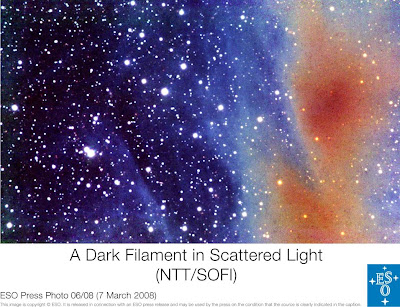Astronomers have measured the distribution of mass inside a dark filament in a molecular cloud with an amazing level of detail and to great depth. The measurement is based on a new method that looks at the scattered near-infrared light or 'cloudshine' and was made with ESO's New Technology Telescope. Associated with the forthcoming VISTA telescope, this new technique will allow astronomers to better understand the cradles of newborn stars.

The vast expanses between stars are permeated with giant complexes of cold gas and dust opaque to visible light. Yet these are the future nurseries of stars to be.
"One would like to have a detailed knowledge of the interiors of these dark clouds to better understand where and when new stars will appear," says Mika Juvela, lead author of the paper in which these results are reported.
Because the dust in these clouds blocks the visible light, the distribution of matter within interstellar clouds can be examined only indirectly. One method is based on measurements of the light from stars that are located behind the cloud [1] .
"This method, albeit quite useful, is limited by the fact that the level of details one can obtain depends on the distribution of background stars," says co-author Paolo Padoan.
In 2006, astronomers Padoan, Juvela, and colleague Veli-Matti Pelkonen, proposed that maps of scattered light could be used as another tracer of the cloud's inner structure, a method that should yield more advantages. The idea is to estimate the amount of dust located along the line of sight by measuring the intensity of the scattered light.
Dark clouds are feebly illuminated by nearby stars. This light is scattered by the dust contained in the clouds, an effect dubbed 'cloudshine' by Harvard astronomers Alyssa Goodman and Jonathan Foster. This effect is well known to sky lovers, as they create in visible light wonderful pieces of art called 'reflection nebulae'. The Chameleon I complex nebula is one beautiful example.
When making observations in the near-infrared, art becomes science. Near-infrared radiation can indeed propagate much farther into the cloud than visible light and the maps of scattered light can be used to measure the mass of the material inside the cloud.
To put this method to the test and use it for the first time for a quantitative estimation of the distribution of mass within a cloud, the astronomers who made the original suggestion, together with Kalevi Mattila, made observations in the near-infrared of a filament in the Corona Australis cloud [2] . The observations were made in August 2006 with the SOFI instrument on ESO's New Technology Telescope at La Silla, in the Chilean Atacama Desert. The filament was observed for about 21 hours.
Their observations confirm that the scattering method is providing results that are as reliable as the use of background stars while providing much more detail.
"We can now obtain very high resolution images of dark clouds and so better study their internal structure and dynamics," says Juvela. "Not only is the level of details in the resulting map no longer dependent on the distribution of background stars, but we have also shown that where the density of the cloud becomes too high to be able to see any background stars, the new method can still be applied."
"The presented method and the confirmation of its feasibility will enable a wide range of studies into the interstellar medium and star formation within the Milky Way and even other galaxies," says co-author Mattila.
"This is an important result because, with current and planned near-infrared instruments, large cloud areas can be mapped with high resolution," adds Pelkonen. "For example, the VIRCAM instrument on ESO's soon-to-come VISTA telescope has a field of view hundreds of times larger than SOFI. Using our method, it will prove amazingly powerful for the study of stellar nurseries."
Notes
[1]: When the light from the background stars passes through the cloud, it is absorbed and scattered, resulting in the background stars appearing redder than they really are. The effect is proportional to the amount of obscuring material and is therefore largest for stars that are situated behind the cloud's densest parts. By measuring the degree of this 'reddening' experienced by stars seen through different areas of the cloud, it is thus possible to chart the distribution of dust in the cloud. The finer the net of background stars is, the more detailed this map will be and the better the information about the internal structure of the cloud. And that is exactly the problem. Even small clouds are so opaque that very few background stars can be seen through them. Only large telescopes and extremely sensitive instruments are able to observe a sufficient number of stars in order to produce significant results (see ESO 01/01).
[2]: Located in the constellation of the same name ('Southern Crown'), the Corona Australis molecular cloud is shaped like a 45 light year long cigar. Located about 500 light years away, it contains the equivalent of about 7000 Suns. On the sky, the dark cloud is surrounded by many beautiful 'reflection nebulae'.
[3]: Observations of a star-forming cloud with ESO's VLT and based on near-infrared scattering is available as ESO Press Photo 26/03.Mika Juvela
Helsinki University Observatory
E-mail: mika.juvela (at) helsinki.fi